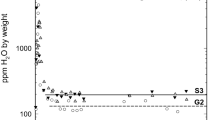Abstract
To investigate the solubility and the sites of incorporation of hydrogen in olivine as a function of point defect concentration, two-stage high-temperature annealing experiments have been carried out. The first annealing stage (the dry preannealing stage) was conducted at a total pressure of 0.1 MPa, a temperature of 1300° C and various oxygen fugacities in the range 10−11–10−4 MPa for times > 12 h. In these heat treatments, the samples were buffered against either orthopyroxene or magnesiowustite, or they remained unbuffered. The second annealing stage (the hydrothermal annealing stage) was performed at 300 MPa and 900–1050 ° C under a hydrogen fugacity of ∼ 158 MPa for 1–5 h. Infrared spectra from the annealed samples revealed two distinct groups of bands. Group I bands occurred at wavenumbers in the range 3450–3650 cm−1, while Group II bands occurred in the range 3200–3450 cm−1. The hydrogen solubility associated with Group I bands is proportional to f O 2 to the 1/6 power for samples preannealed in contact with orthopyroxene, to the 1/3 power for samples preannealed in contact with magnesiowustite, and to the 1/13 power for samples preannealed in the absence of a solid-state buffer. The hydrogen concentration for Group II bands varies with f o 2 to the 1/3 power for opxbuffered samples, to the 1/2 power for mw-buffered samples, and to the 1/3 power for unbuffered samples. The dependence of hydrogen solubility on oxygen fugacity and orthopyroxene activity suggests that hydrogen is incorporated into the olivine structure via association with point defects. The presence of two distinct groups of absorption bands indicates that hydrogen is associated with two distinct lattice defects. The following point defect model for the mechanism of incorporation of hydrogen in olivine is consistent with these results: Hydrogen ions responsible for the Group I bands are associated with doubly charged oxygen interstitials, while hydrogen ions responsible for the Group II bands are associated with singly charged oxygen interstitials. Furthermore, the infrared bands observed in naturally derived olivines are present in spectra from our hydrothermally annealed crystals. Thus, the mechanisms of incorporation of hydrogen in olivine under geological conditions are the same as those operative under laboratory conditions. The maximum solubility reached in these experiments was ∼ 360H/106Si, which corresponds to ∼ 0.002 wt% of H2O. This value is a lower bound for the solubility of hydrogen in olivine under upper mantle conditions.
Similar content being viewed by others
References
Bai Q, Kohlstedt DL (1992a) High-temperature creep of olivine single crystals 3. Mechanical results for unbuffered samples and creep mechanisms. Philos Mag Part A (in press)
Bai Q, Kohlstedt DL (1992b) Substantial hydrogen solubility in olivine and implication for water storage in the mantle. Nature 357:672–674
Bai Q, Mackwell SJ, Kohlstedt DL (1991) High-temperature creep of olivine single crystals 1. Mechanical results for buffered samples. J Geophys Res 96:2441–2463
Bell DR, Rossman GR (1992) Water in Earth's mantle: The role of nominally anhydrous minerals. Science 255:1391–1397
Freund F, Oberheuser G (1985) Water dissolved in olivine: A single crystal infrared study. J Geophys Res 90:1–44
Hobbs BE (1984) Point defect chemistry of minerals under a hydrothermal environment. J Geophys Res 89:4026–4038
Karato S (1990) The role of hydrogen in the electrical conductivity of the upper mantle. Nature 347:272–273
Karato S, Paterson MS, FitzGerald JD (1986) Rheology of synthetic olivine aggregates: Influence of grain size and water. J Geophys Res 91:8151–8176
Kingery WD, Bowen HK, Uhlmann DR (1976) Introduction to ceramics. 2nd edn. Wiley, New York
Kröger FA, Vink HJ (1956) Relations between the concentrations of imperfections in crystalline solids. In: Solid state physics, vol 3, Seitz F, Turnball D (eds). Academic Press, New York, pp 307–435
Kushiro I (1990) Partial melting of mantle wedge and evolution of island arc crust. J. Geophys Res 95:15929–15939
Mackwell SJ, Kohlstedt DL, Paterson MS (1985) The role of water in the deformation of olivine single crystals. J Geophys Res 90:11319–11333
Mackwell SJ, Dimos D, Kohlstedt DL (1988) Transient creep of olivine: Point-Defect relaxation time. Philos Mag A57:779–789
Mackwell SJ, Kohlstedt DL (1990) Diffusion of hydrogen in olivine: Implications for water in the mantle. J Geophys Res 95:5079–5088
Medaris LG Jr (1969) Partitioning of Fe and Mg between coexisting synthetic olivine and orthopyroxene. Am J Sci 267:945–968
Miller GH, Rossman GR, Harlow GE (1987) The natural occurrence of hydroxide in olivine. Phys Chem Minerals 14:461–472
Nafziger RH, Muan A (1967) Equilibrium phase compositions and thermodynamic properties of olivines and pyroxenes in the system MgO-“FeO”-SiO2. Am Mineral 52:1364–1385
Nakamura A, Schmalzried H (1983) On the nonstoichiometry and point defects of olivine. Phys Chem Minerals 10:27–37
Nakamura A, Schmalzried H (1984) On the Fe2+-Mg2+-interdiffusion in olivine (II). Ber Bunsenges Phys Chem 88:140–145
Nitsan U (1974) Stability field of olivine with respect to oxidation and reduction. J Geophys Res 79:706–711
Paterson MS (1982) The determination of hydroxyl by infrared absorption in quartz, silicate glasses and similar materials. Bull Mineral 105:20–29
Robie RA, Hemingway BS, Fisher JR (1978) Thermodynamic properties of minerals and related substances at 298.15 K and 1 bar (105 Pascal) pressure and at higher temperatures. US Geo Surv Bull 1452
Schock RN, Duba AG, Shankland TJ (1989) Electrical conduction in olivine. J Geophys Res 94:5829–5839
Stocker RL, Smyth DM (1978) Effect of enstatite activity and oxygen partial pressure on the point-defect chemistry of olivine. Phys Earth Planet Inter 16:146–156
Wilkins RWT, Sabine W (1973) Water content of some nominally anhydrous silicates. Am Mineral 58:508–516
Author information
Authors and Affiliations
Rights and permissions
About this article
Cite this article
Bai, Q., Kohlstedt, D.L. Effects of chemical environment on the solubility and incorporation mechanism for hydrogen in olivine. Phys Chem Minerals 19, 460–471 (1993). https://doi.org/10.1007/BF00203186
Received:
Revised:
Accepted:
Issue Date:
DOI: https://doi.org/10.1007/BF00203186




